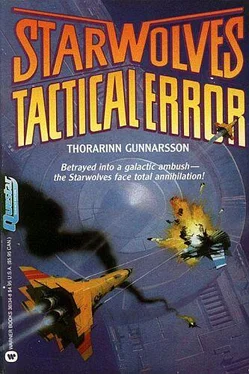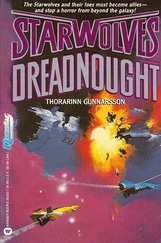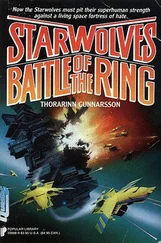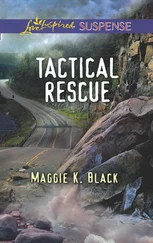Trace frowned, displeased with the situation all the way around. He wished that Maeken Kea could have been here to command this ship. He wished even more that he could have spared her to lead the attack on Alkayja, but he dared not. She was too valuable held in reserve to pick up the pieces if something went wrong. And there were no bright, competent Feldenneh to crew his ships, their race once again refusing to accept duty in military ships.
“I think I know,” he said, pausing a moment to watch the screen. “They can lose themselves even from scan by dropping down into the upper reaches of the hydrogen layer, but it’s not just to hide. They can jump out of cover from time to time to draw our fire, showing themselves just enough to give us a ghost image and invite us to start mining the clouds with our missiles. If we throw away our missiles on the Methryn, then we cannot destroy Terra.”
“We ignore them, sir?” Avaires asked.
He shook his head. “Taking the Methryn is more important than destroying one essentially uninhabited world. But I do not want to throw everything we have at them and still have the Methryn hiding in these clouds. Order the Fortresses to spread themselves in an evenly spaced orbit as close as we dare to go down. The moment they show, I want to be able to drop a dozen missiles on and ahead of them before they can go back down.”
“Yes, sir.”
“Have missile bearing stingships ready to go down into the atmosphere if we get the chance, but launch no ships until I give the orders,” Trace added. “I want no energy emissions or other types of clutter in space to distract those scan images. Settle the ships in close orbit and close down the engines, but have shields standing by.”
“At once, sir.” Avaires hurried to the com station to relay those orders.
Trace stood alone on the bridge, watching as the Starwolf carrier disappeared into the deeper reaches of the planet’s hydrogen shell.
The Valcyr slowed quickly as she penetrated through Jupiter’s dense atmosphere and into the depthless ocean of liquid hydrogen. She elongated her shields even more, bringing them up to even greater strength as the pressures continued to mount, trapping a pool of low-pressure liquid hydrogen within her shields to act as insulation against the increasing temperature. Pouring all the power she dared through her main drives, she was barely able to maintain an initial speed of about seventeen thousand kilometers. That speed would continue to fall as she pushed steadily deeper and tremendous pressures turned the hydrogen from liquid to a thick plastic.
The heat was a strong consideration. Her shields were opaque to the radiation of heat, but temperatures inside that shell continued to climb. She had actually planned that reaction, since the volume of low-pressure hydrogen within the shell would try to expand as it warmed, providing outward pressure to reinforce the shields. Even so, the ship itself would eventually begin to heat dangerously as the trapped hydrogen against its hull warmed. Quendari estimated that she faced a journey of at least two-and-a-half hours, a long time to survive temperatures that might eventually reach twelve to fifteen thousand degrees in the surrounding hydrogen.
She was running blind, even her space-distorting achronic sensors hopelessly scrambled by the fierce electric and magnetic currents running through the liquid hydrogen. Visual was even more useless, and she kept her main viewscreen blanked out. She was orienting herself by the pull of gravity as she aimed straight down toward the heart of the planet, estimating her progress as best she could from her speed and the external pressure against her shields. At almost exactly two-and-a-half hours, her speed began to slow to a relative crawl. She had penetrated more than halfway to the core of the planet to the depth of liquid, metallic hydrogen, turned into a dense, molten, metallic substance by the tremendous temperatures and pressures.
“This is as far as we go,” Quendari announced. “My speed has been cut so low that I could spend hours trying to push forward enough to make any difference in our distance from the core.”
“Are they still out there?” Keflyn asked.
“Yes, I suppose,” she answered, not very certain. The drone that she had left had only one command, to transmit a tight, achronic beam into the core of the planet if the fleet moved out of close orbit. Otherwise it was to keep communication silence, reducing the possibility if giving itself away.
“We might as well do it,” Keflyn agreed. “At your discretion.”
“Warming the conversion cannon for firing, building the power reserve to one hundred percent,” Quendari reported. “The jump drive is powered up and standing by.”
Keflyn nodded. “When you are ready.”
She would have been amused, if the circumstances had not been so incredible. Quendari persisted in granting her every courtesy as Commander, although she felt that she was just along for the ride. She had been able to make a few suggestions in recalibrating the jump drive so that it was far less likely to run away with itself, until permanent alterations could be made.
“All ready,” Quendari reported a few moments later. “At my count. Three. Two. One.”
The tubular shield of the conversion cannon shot out from the nose of the Valcyr, striking deep into the heart of the planet to its rocky core, and Quendari poured all the power she had to give through that passage. Jupiter was just large enough to be a failed star, lacking the mass to generate the pressures and temperatures in the liquid, metallic hydrogen to allow fusion reactions to begin. Quendari bridged that gap, pouring billions of megatons of explosive force into the heart of the planet. Fusion began as a sudden spark, adding more and more power into the system with each small reaction, the process expanding so rapidly that the heart of the planet went up in a flash of stellar flame.
Driven by that fierce, internal heat, the outer hydrogen shell of the planet expanded rapidly outward as it was warmed from within. The Fortresses came quickly to life in a desperate attempt to engage their engines and escape as the bands of color melted away in a stellar flare of brilliant light and searing heat, and the surface of the newborn star reached out to trap them. Some ran a short distance before they were caught, while others hid within their shields before the defensive shells were overloaded and collapsed.
Barely twenty million kilometers away, space itself erupted in a sudden flare of white-hot gas. The Valcyr hurtled out of the core of that brief, brilliant explosion, the substance of stellar material suddenly released from under vast pressures as it was carried through with the carrier’s short jump. She looped around wide, coasting on the thrust of her jump, turning back for a clear view of the new star.
“We got them?” Keflyn asked, daring to look up and see that they had indeed survived.
“Nothing escaped that I have detected,” Quendari reported. “I am still scanning the area carefully for even small ships, although I doubt that they had time to even think about getting to their escape pods. In fact, escape pods would not have had the speed to escape the shock wave.”
“And yourself?” Keflyn asked as she lifted herself from her seat at the commander’s station.
“My condition appears to be perfect. Even my conversion cannon seems to have survived the firing.”
Keflyn nodded. “Set course for Alkayja, then. Best possible speed, with the largest jumps you dare take. We might not yet be too late.” She paused at the bottom of the steps. “I do not like to leave Terra itself unprotected, with the possibility of more Union warships coming along behind the main fleet at any time.”
Читать дальше












